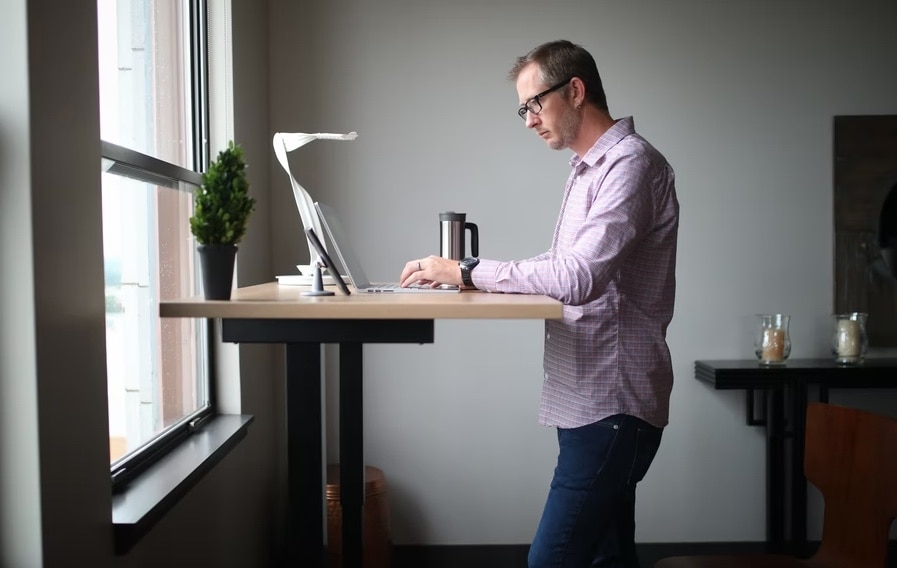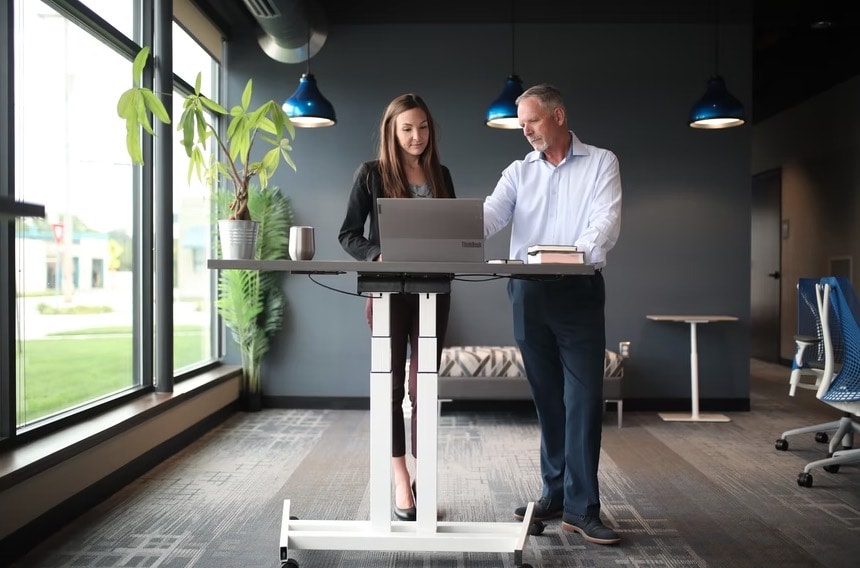Working in a confined space can be challenging, especially when it comes to setting up a functional and efficient workspace. One of the most critical elements in a home or office workspace is the desk.
You want it to be large enough to accommodate your computer and essential items, yet compact enough to leave room for other furniture or decorations. In this guide, we’ll explore key factors to consider when choosing a desk for small spaces, including practical tips for maximizing your available room.
Let’s Get Straight To The Point
Setting up a functional workspace in small spaces can be challenging, but choosing the right desk is key. Consider size, storage, and design to balance functionality without cluttering the room.
Compact writing desks, L-shaped desks, and floating desks are great space-saving options. Look for built-in storage solutions like drawers and vertical shelves. Ensure the desk’s height and depth fit your needs for comfort and efficiency.
Opt for slim office chairs to save space, and maintain a minimalist setup to keep your workspace organised. Finally, prioritise quality and durability when selecting a desk.
1. Importance Of Desk Size In Small Spaces
The primary consideration when purchasing a desk for a small space is its size. A well-chosen desk can help you stay organised without overwhelming your room. The wrong desk size can make the room feel cluttered and uncomfortable. Finding a balance between functionality and available space is key.
Why Size Matters
When selecting a desk, it’s essential to measure the available space before making a purchase. Desks that are too large can dominate the room, leaving little room for movement or additional furniture. On the other hand, desks that are too small may not provide enough surface area to accommodate your work tools.
Recommended Desk Dimensions
A good starting point for desk dimensions in a small room is a width of at least 610 mm and a depth of between 712 mm and 762 mm. Desks in this size range provide ample room for a computer monitor, keyboard, and other essentials while being compact enough to fit into small spaces.
2. Types Of Desks For Small Spaces
There are various types of desks designed specifically for small rooms. Here are a few options to consider:
Compact Writing Desks
Writing desks are typically narrow and feature minimalist designs. They are perfect for small rooms where you need a simple surface to place your laptop or paperwork. These desks often come with a few small drawers or open storage shelves.
L-Shaped Desks
An L-shaped desk is ideal for corner spaces, allowing you to maximize the use of an underutilised area. These desks provide more surface space while leaving the central part of the room open. This makes them perfect for bedrooms or multi-purpose rooms where space is a premium.
Floating Desks
Floating desks are mounted directly to the wall, freeing up floor space. These desks are ideal for extremely tight quarters, such as studio apartments. They offer just enough surface area for a laptop and a few office supplies without encroaching on the rest of the room.
3. Maximizing Desk Storage In Small Spaces
Storage can be a significant challenge in small rooms. Desks with built-in storage solutions can help you stay organised without taking up additional floor space. When selecting a desk, look for models that offer a combination of drawers, shelves, or under-desk storage options.

Desks With Drawers And Shelves
Desks that include drawers or shelves can help you store essential items like paperwork, pens, and office supplies. Some desks even feature storage areas underneath the surface, which is useful for keeping items close at hand without cluttering your workspace.
Vertical Storage Solutions
If you don’t have room for wide drawers or filing cabinets, consider vertical storage options like shelves above your desk. This not only saves floor space but also helps you keep your workspace tidy by storing books, files, or personal items on higher levels.
4. Choosing The Right Desk Height And Depth
Selecting the appropriate desk height and depth is crucial for both comfort and functionality. If the desk is too high or too deep, you may struggle to maintain a comfortable working posture. This can lead to discomfort over time, especially if you spend long hours at your desk.
Optimal Desk Depth
A depth of 712 mm to 762 mm is recommended for most computer desks. This depth provides enough room for your computer and workspace necessities without taking up excessive room. If you plan to add under-desk storage, make sure it doesn’t protrude past the surface, which could impede legroom.
Desk Height
The standard desk height is around 750 mm, which is suitable for most people. However, if you’re taller or shorter than average, it’s important to test out desks to ensure they provide adequate legroom and don’t strain your posture.
5. Clever Seating Solutions For Small Offices
Selecting the right chair is just as important as choosing the right desk, especially in small spaces. A bulky office chair can take up valuable floor space and make the room feel cramped. Instead, opt for seating options that offer comfort without excessive bulk.
Slim Office Chairs
A slim office chair that can easily slide under the desk is a smart choice for small spaces. Avoid chairs with wide armrests or large bases, as these can consume too much room. Some desk chairs are designed to double as dining chairs or accent chairs, making them versatile options for compact living spaces.
6. Practical Tips For Keeping A Small Workspace Organized
A small workspace can quickly become cluttered, making it difficult to focus and stay productive. Keeping your workspace clean and organised is essential to maintaining efficiency in a small room. Here are some tips for keeping things tidy.
Minimalist Setup
A minimalist setup can help reduce distractions and maximise desk space. Limit your desk items to the essentials, such as your computer, keyboard, mouse, and a few personal items like a photo or small plant.
Vertical Filing Solutions
Instead of using large filing cabinets, opt for vertical filing solutions like wall-mounted file holders or stacked trays. These take up less room while keeping your important documents within easy reach.
7. Best Desks For Standing Workstations In Small Spaces
If you prefer a standing desk but are limited in space, there are options designed specifically for compact environments. Standing desks are beneficial for promoting better posture and reducing the health risks associated with prolonged sitting.
Shallow Depth Standing Desks
Shallow-depth standing desks, which range from 23.5 inches to 28 inches deep, are excellent choices for small apartments or dorm rooms. These desks provide just enough space for a laptop and a few essential items without overwhelming the room. They are perfect for those who prefer a minimalist setup but still want the benefits of a standing desk.
Adjustable Height Desks
An adjustable-height desk allows you to switch between sitting and standing, which is a great option for small workspaces. Many models offer slim profiles and compact designs, making them suitable for even the tiniest of rooms.

8. Quality And Durability: What To Look For In A Desk
When purchasing a desk, it’s important to invest in quality furniture that will last. Cheaper materials may save you money upfront, but they often wear out quickly and may not offer the necessary support for your workspace needs.
Material Considerations
Look for desks made from high-quality materials such as hardwood or metal. Desks made from hardwood, such as mahogany or oak, are durable and can withstand years of use. Metal desks are also sturdy and can offer a modern aesthetic.
Budget Vs. Quality
While it’s essential to stay within your budget, don’t sacrifice comfort or durability. A well-made desk will not only last longer but will also provide a more comfortable and functional workspace.
9. Keeping The Workspace Uncluttered
To maintain an efficient and comfortable workspace in a small room, it’s important to keep your desk free from unnecessary clutter. Maintaining a decluttered workspace can help improve productivity and reduce stress.
Simplifying Your Desk Setup
To keep things simple, limit your desk setup to the essentials: your computer, keyboard, mouse, and a few key items like a notepad or lamp. Remove any unnecessary decorations or items that don’t serve a practical purpose in your workspace.
Regular Cleaning Routine
Establish a regular cleaning routine to keep your workspace organised. This might involve tidying up at the end of each workday, wiping down surfaces, and filing away papers or other items.
Conclusion
Choosing the right desk for a small space requires careful consideration of factors like size, storage, and functionality. The key is to find a desk that maximises the available room without overwhelming it. Whether you opt for a compact writing desk, a floating desk, or a shallow standing desk, always take measurements and think about how you will use the space. By selecting the appropriate desk and keeping your workspace organised, you can create a productive and comfortable environment, even in the smallest of rooms.
FAQs About Desks
How Do You Fit A Desk In A Small Space?
A demilune or hall table can make a nice small desk or laptop table and doesn’t take up too much space. You could place one in your entryway, behind the sofa, or on a blank wall, move a chair up to it when necessary, and have it serve as a console table the rest of the time.
How Do I Choose A Desk Size?
You should buy a desk with dimensions that serve your usage most appropriately. A standard large desk size that will suit most uses is 60-inch x 30-inch, with a height 30-inches. These dimensions will comfortably accommodate most general use cases and should be used as a baseline.
Where Should I Put My Desk?
Place your desk as close to a natural light source as possible. You should also place your desk as close to a natural light source as possible. Some like to face the window, but if that proves too distracting, put the desk perpendicular to it.
How Small Can A Desk Be?
Although there’s no standard size for typical desks, they are commonly 48, 60, or 72 inches wide and 24, 30, or 36 inches deep, according to Houzz. A great small desk would have smaller dimensions but still provide enough space for at least a laptop.
Is A Height-Adjustable Desk Really Necessary?
Desks that can be adjusted to a variety of heights are thought to boost employee productivity in addition to providing health benefits.
According to a study done by Work, 65 per cent of people who had height-adjustable desks reported increased productivity after one year. These same people also reported improved ability to concentrate.

